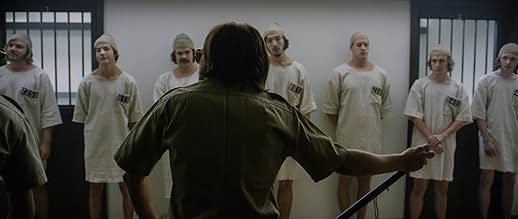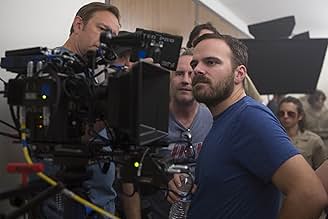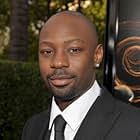In 1971, twenty-four male students are selected to take on randomly assigned roles of prisoners and guards in a mock prison situated in the basement of the Stanford psychology building.In 1971, twenty-four male students are selected to take on randomly assigned roles of prisoners and guards in a mock prison situated in the basement of the Stanford psychology building.In 1971, twenty-four male students are selected to take on randomly assigned roles of prisoners and guards in a mock prison situated in the basement of the Stanford psychology building.
- Awards
- 4 wins & 3 nominations
- Director
- Writers
- All cast & crew
- Production, box office & more at IMDbPro
Storyline
Did you know
- TriviaAlthough never mentioned in the movie, the real life experiment was funded by the U.S. Office of Naval Research and was of interest to both the U.S. Navy and Marine Corps as an investigation into the causes of conflict between military guards and prisoners.
- GoofsWhen Dr. Zimbardo speaks with his colleague, the colleague says that he will see him at the beginning of the semester. Stanford does not have semesters; rather, it has a quarter academic calendar.
- Quotes
Daniel Culp: I know you're a nice guy.
Christopher Archer: So why do you hate me?
Daniel Culp: Because I know what you can become.
Featured review
I've always been fascinated by the original Stanford prison experiment. It always had the ingredients for a fascinating study of human behaviour. Its conductor Dr. Philip Zimbardo knew that, it just had to be played out. Of course, The Stanford Prison Experiment is a story that's been notably portrayed before, such as the 2001 German film Das Experiment. I remember being a fan of it when I first saw it, but I admit I can't quite recall it enough to make a comparison here. Nevertheless, this American version which doesn't make substitutions is a preferable version, one that makes resourceful use of today's technology and young talent. There's a dual study going on here. One, the part that writes itself, a document of the actual experiment. And the other, an examination of the ethics of the experimenters. Here is the ugly side of the human condition and our desires to push one another to feel the sweet taste of superiority.
While it may lend the obvious yet compelling results of what imaginary power and authority does to people, it still needs to be well executed to work. Fortunately director Kyle Patrick Alvarez and writer Tim Talbott have the right handling of the material, working with great economy in balancing its dichotomy's. At first it's disarmingly casual in the way the volunteers are selected and summoned, making a point of its randomizations and often offering an endearing and natural sense of humour. While superficially bleak, it's having fun with the 70s clothes and oversized moustaches, without peeling back their integrity. But then real tension, real anguish, and a real sensation of danger and dread creeps in and The Stanford Prison Experiment becomes deeply unsettling in its dehumanization techniques. With a careful sense from Alvarez of how far to escalate each sequence, it rings true to human sensibilities of what would happen in this unique situation. There's always a reminder that it isn't real, but it doesn't stop you from feeling unbearably trapped. This is nature at work, combined with a touch of modern cruelty.
There is a tendency in the film's inherent and forgivably episodic narrative that it gets you attached to a character they're focusing on only due to their upcoming exit. Thereby the film loses steam bit by bit. It gradually wins you back afterwards, but each time it takes a little longer. Ezra Miller in particular is a highlight of the first half of the film, formulating some of the most memorable instances of the prisoner's rebellions and reluctances. He's missed, but his absence only breeds more tension and vulnerability as we're left with weaker willed volunteers. If anything, this film is an impressive display of the best talent from the next generation of actors. Hopefully all to soon be familiar faces; Johnny Simmons, Tye Sheridan, Brett Davern, and a guard with the most inventive choice of wording, Michael Angarano, all stick out among other strong performances. While a crowded ensemble does mean no character gets to be fleshed out to their full potential, Alvarez and Talbott at least give room for everyone a time to shine without any dim spots.
On the experimenters end, Billy Crudup is perfect casting as Dr. Zimbardo. Donning a beard that gives him an uncanny resemblance to Satan, it doesn't remove that trustworthy glint of compassion in his eyes. His usual warmth is countered by his malicious intent to shove the volunteers to their limits and it creates an enthralling inner conflict where he's finding his own limits. The film admittedly does lack a female presence giving the nature of 24 volunteers and all the scientists being men. Its only example is Olivia Thirlby as Zimbardo's girlfriend who later involves herself in the experiment and becomes a voice of reason, but a very welcome one. It may have blind spots and a few stumbles, but it doesn't hinder what the film does right. As I was completely wrapped in its deft and dense confrontations, I kept waiting for the film to explode. Perhaps recalling the more gritty approach Das Experiment took to its second half, instead this implodes, which is a much more restrained and satisfying conclusion to watch these invisible social constructs dissolve rather than erupt.
The Stanford Prison Experiment's wealth of strong material and performances are matched by its technical ambitions. The slick photography makes it cinematic with liberal collages of close-ups and swift camera moves but still keeping it intimate. When the scene calls for rigid obedience, any time the camera moves out of line we hold our breath. It's graded with a washed-out atmosphere, relishing in the moody darkness. I've been irritated with indie films that abuse a shallow depth of field in their photography for no good reason, but this film uses it to isolate you in its grasp and as a result the film shook me up for the rest of the day. While it gets under the skin of the prisoners and the scientists, I did find myself wanting to get behind the motivations of the guards, the most vocal contributors of the experiment. Instead, thats saved for an epilogue that feels like a wise afterthought, but it's a powerful note on the personal experiments we run just because the opportunity is there. The Stanford Prison Experiment is an ideal taut psychological thriller that bristles with youthful energy and will mostly likely remain standing as one of the best of the year.
8/10
While it may lend the obvious yet compelling results of what imaginary power and authority does to people, it still needs to be well executed to work. Fortunately director Kyle Patrick Alvarez and writer Tim Talbott have the right handling of the material, working with great economy in balancing its dichotomy's. At first it's disarmingly casual in the way the volunteers are selected and summoned, making a point of its randomizations and often offering an endearing and natural sense of humour. While superficially bleak, it's having fun with the 70s clothes and oversized moustaches, without peeling back their integrity. But then real tension, real anguish, and a real sensation of danger and dread creeps in and The Stanford Prison Experiment becomes deeply unsettling in its dehumanization techniques. With a careful sense from Alvarez of how far to escalate each sequence, it rings true to human sensibilities of what would happen in this unique situation. There's always a reminder that it isn't real, but it doesn't stop you from feeling unbearably trapped. This is nature at work, combined with a touch of modern cruelty.
There is a tendency in the film's inherent and forgivably episodic narrative that it gets you attached to a character they're focusing on only due to their upcoming exit. Thereby the film loses steam bit by bit. It gradually wins you back afterwards, but each time it takes a little longer. Ezra Miller in particular is a highlight of the first half of the film, formulating some of the most memorable instances of the prisoner's rebellions and reluctances. He's missed, but his absence only breeds more tension and vulnerability as we're left with weaker willed volunteers. If anything, this film is an impressive display of the best talent from the next generation of actors. Hopefully all to soon be familiar faces; Johnny Simmons, Tye Sheridan, Brett Davern, and a guard with the most inventive choice of wording, Michael Angarano, all stick out among other strong performances. While a crowded ensemble does mean no character gets to be fleshed out to their full potential, Alvarez and Talbott at least give room for everyone a time to shine without any dim spots.
On the experimenters end, Billy Crudup is perfect casting as Dr. Zimbardo. Donning a beard that gives him an uncanny resemblance to Satan, it doesn't remove that trustworthy glint of compassion in his eyes. His usual warmth is countered by his malicious intent to shove the volunteers to their limits and it creates an enthralling inner conflict where he's finding his own limits. The film admittedly does lack a female presence giving the nature of 24 volunteers and all the scientists being men. Its only example is Olivia Thirlby as Zimbardo's girlfriend who later involves herself in the experiment and becomes a voice of reason, but a very welcome one. It may have blind spots and a few stumbles, but it doesn't hinder what the film does right. As I was completely wrapped in its deft and dense confrontations, I kept waiting for the film to explode. Perhaps recalling the more gritty approach Das Experiment took to its second half, instead this implodes, which is a much more restrained and satisfying conclusion to watch these invisible social constructs dissolve rather than erupt.
The Stanford Prison Experiment's wealth of strong material and performances are matched by its technical ambitions. The slick photography makes it cinematic with liberal collages of close-ups and swift camera moves but still keeping it intimate. When the scene calls for rigid obedience, any time the camera moves out of line we hold our breath. It's graded with a washed-out atmosphere, relishing in the moody darkness. I've been irritated with indie films that abuse a shallow depth of field in their photography for no good reason, but this film uses it to isolate you in its grasp and as a result the film shook me up for the rest of the day. While it gets under the skin of the prisoners and the scientists, I did find myself wanting to get behind the motivations of the guards, the most vocal contributors of the experiment. Instead, thats saved for an epilogue that feels like a wise afterthought, but it's a powerful note on the personal experiments we run just because the opportunity is there. The Stanford Prison Experiment is an ideal taut psychological thriller that bristles with youthful energy and will mostly likely remain standing as one of the best of the year.
8/10
- Sergeant_Tibbs
- Aug 7, 2015
- Permalink
- How long is The Stanford Prison Experiment?Powered by Alexa
Details
- Release date
- Country of origin
- Official site
- Language
- Also known as
- Untitled Stanford Prison Experiment Project
- Filming locations
- Production companies
- See more company credits at IMDbPro
Box office
- Gross US & Canada
- $660,561
- Opening weekend US & Canada
- $37,514
- Jul 19, 2015
- Gross worldwide
- $663,114
- Runtime2 hours 2 minutes
- Color
- Aspect ratio
- 2.35 : 1
Contribute to this page
Suggest an edit or add missing content



























